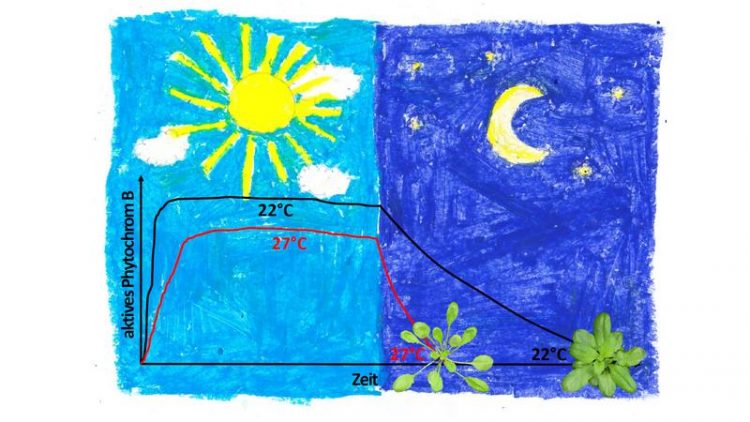How Plants Measure Temperature

The level of active phytochrome B is regulated by light and temperature. Phytochrome B is inactivated more strongly at higher temperatures, promoting elongation growth of plants. Photo: Cornelia Klose
Plants respond very sensitive to temperature changes in their environment. At 22 degrees Celsius, for example, the model plant Arabidopsis shows compact growth. But if the temperature rises only a few degrees, plants exhibit an increased elongation growth in the shoot and leaves, enabling plant organs to cool down more easily by evaporation.
How plants sense temperature was unknown, until now. In two complementary studies published in Science magazine, researchers from the University of Freiburg collaborated with researchers from Cambridge, England; Buenos Aires, Argentina; and St. Louis, Missouri, USA, to demonstrate how the light receptor phytochrome B also works as a temperature sensor in plants.
Phytochromes are photoreceptor proteins that control a number of physiological processes in higher plants, including seed germination, seedling development, induction of flowering and the shade avoidance. The spectral composition of a plant’s light environment changes according to where the plant is growing: The proportion of red light is high in the direct sunlight, while in the shade of vegetation, blue and red light is filtered out, and far red becomes enriched.
Phytochromes can absorb light and act as light driven molecular switches. While the red light portion in sunlight activates phytochromes, far red light inactivates them. Based on this, plants are able to determine the amount of red light in their light environment. Active phytochrome B inhibits elongation growth and promotes compact plant growth instead. It binds to regulatory sequences, or promoters, of certain genes involved for example in the regulation of elongation growth, thus controlling their activity.
It has been known for some time that phytochromes can change from the active to the inactive state, regardless of light conditions. This process is known as dark reversion. The plant physiologists from the University of Freiburg demonstrated previously that the inactivation of phytochrome B via dark reversion can occur in reactions with two different speeds.
A slower dark reversion mechanism ensures that the amount of active phytochrome B gradually declines during the night. A second, about 100 times faster reversion process competes with the light activation of phytochrome B and thus allows the plant to measure the intensity of light during the day. Besides, the researchers discovered that the speed of these two inactivation processes depends strongly on temperature.
Using a special spectroscopy method that allows measuring the amount of active phytochrome B in living seedlings, the scientists demonstrated how much temperature affects the two dark reversion rates. The temperature dependency of the slower dark reversion reaction determines how long phytochrome B remains active during the night and can therefore bind to the gene promoters.
At higher temperatures, phytochrome B is inactivated more rapidly and is released from promoters faster than at lower temperatures. Temperature also influences the activity of phytochrome B during the day. At higher temperatures, the researchers detected reduced levels of the photoreceptors’ active form already in the light phase that was caused by the temperature-dependency of the fast dark reversion mechanism.
Rising temperatures inactivate phytochrome B, particularly in weak light, which in turn promotes elongation growth. Using these mechanisms, plants are able to adapt their development to changes in their environment.
The researchers involved in the studies are Dr. Cornelia Klose, Prof. Dr. Andreas Hiltbrunner, and Prof. Dr. Eberhard Schäfer from the Department of Molecular Plant Physiology of the Institute of Biology II at the University of Freiburg. Hitbrunner and Schäfer are members of the BIOSS Centre for Biological Signalling Studies cluster of excellence, also at the University of Freiburg.
Original publications:
Martina Legris, Cornelia Klose, E. Sethe Burgie, Cecilia Costigliolo, Maximiliano Neme, Andreas Hiltbrunner, Philip A. Wigge, Eberhard Schäfer, Richard D. Vierstra, Jorge J. Casal (2016). Phytochrome B integrates light and temperature signals in Arabidopsis. Science. DOI: 10.1126/science.aaf5656
Jae-Hoon Jung, Mirela Domijan, Cornelia Klose, Surojit Biswas, Daphne Ezer, Mingjun Gao, Asif Khan Khattak, Mathew S. Box, Varodom Charoensawan, Sandra Cortijo, Manoj Kumar, Alastair Grant, James C. W. Locke, Eberhard Schäfer, Katja E. Jaeger, Philip A. Wigge (2016). Phytochromes function as thermosensors in Arabidopsis. Science. DOI: 10.1126/science.aaf6005
Contact:
Dr. Cornelia Klose
Faculty of Biology
University of Freiburg
Phone: +49 (0)761 / 203 – 2627
E-Mail: cornelia.klose@biologie.uni-freiburg.de
https://www.pr.uni-freiburg.de/pm/2016/pm.2016-11-15.160-en?set_language=en
Media Contact
All latest news from the category: Life Sciences and Chemistry
Articles and reports from the Life Sciences and chemistry area deal with applied and basic research into modern biology, chemistry and human medicine.
Valuable information can be found on a range of life sciences fields including bacteriology, biochemistry, bionics, bioinformatics, biophysics, biotechnology, genetics, geobotany, human biology, marine biology, microbiology, molecular biology, cellular biology, zoology, bioinorganic chemistry, microchemistry and environmental chemistry.
Newest articles

Superradiant atoms could push the boundaries of how precisely time can be measured
Superradiant atoms can help us measure time more precisely than ever. In a new study, researchers from the University of Copenhagen present a new method for measuring the time interval,…

Ion thermoelectric conversion devices for near room temperature
The electrode sheet of the thermoelectric device consists of ionic hydrogel, which is sandwiched between the electrodes to form, and the Prussian blue on the electrode undergoes a redox reaction…

Zap Energy achieves 37-million-degree temperatures in a compact device
New publication reports record electron temperatures for a small-scale, sheared-flow-stabilized Z-pinch fusion device. In the nine decades since humans first produced fusion reactions, only a few fusion technologies have demonstrated…





















